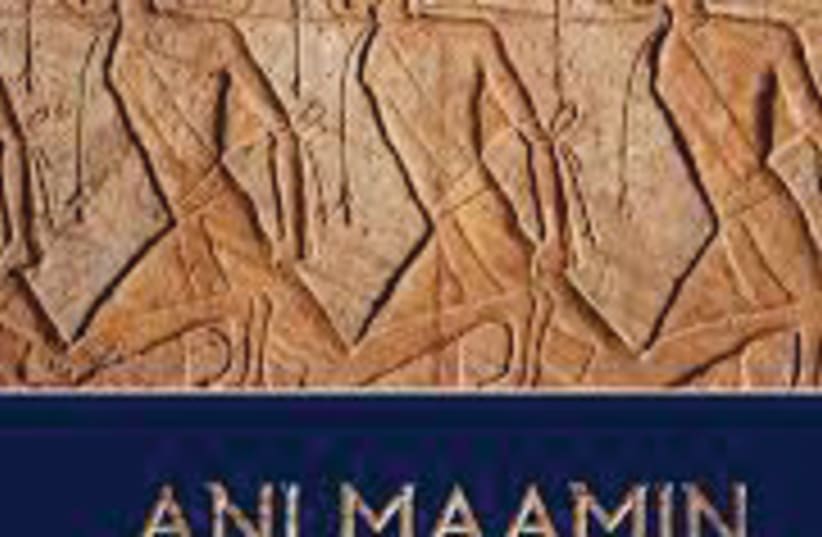As the title of this book states, Rabbi Dr. Joshua Berman’s Ani Maamin: Biblical Criticism, Historical Truth, and the Thirteen Principles of Faith is about belief, and if you have any doubts or questions about the authenticity of the story of the Exodus in the Torah, this book will change the way you think about the Torah and biblical criticism, as it did for me.
There is no more important story than the Exodus of the Jewish people from Egypt. It is the basis of Judaism, the belief in one God, and what became our system of values and ethics upon which Western Civilization is based. But some question if the Exodus happened as described, or even at all, since there is no archaeological evidence to prove its authenticity. Is it, therefore, just a myth? Can belief overcome doubts and the Bible’s critics and skeptics? And does it matter?
If the events described in the Book of Exodus never happened, the implications are serious and devastating. It means that there was no Divine intervention, no encounter with God, no giving of the Ten Commandments, no Mishkan, no Covenant, perhaps no Jewish people, and no concept of the Jewish connection with Eretz Yisrael. If the whole thing was made up, there’s no true Jewish history. It means that the Bible is only a literary work, without any authenticity. The “Laws of Moses,” the doubters claim, are fiction since there was no Moses. And Passover is fiction too.
Rabbi Dr. Berman, a professor of Tanach at Bar-Ilan University, has provided us with a scholarly examination of the story that uses a historical, literary, and linguistic approach. Although there were attempts in the past to use the tools of historians to analyze the Bible, Berman’s book is unique, and stunningly insightful.
Those insights are grounded in a methodology that is common among historians but is absent in the rabbinic world. The challenge of Biblical criticism, Berman insists, should not be ignored, but examined carefully. On a range of key issues, Berman demonstrates that these challenges can be met by using the tools of academic Bible study themselves: a critique of the criticism itself. The problem, as Berman demonstrates, is that our educators are not equipped with the tools to do this. Berman provides the tools. “Everything is accepted in the name of truth,” he writes, “but nothing is rejected in the name of truth.”
Berman effectively marshals one of the pillars of modern critical study of the Bible, the so-called comparative method. Scholars elucidate a Biblical text by noting similarities between it and texts found among the cultures adjacent to ancient Israel. Because the similarities are high in number and distinctive in both sources, it is plausible to assume that the Biblical text may have been written under the direct influence of, or in response to, the extra-Biblical text.
As an example, consider how at the Seder table we recall how God delivered Israel from Egypt “with a mighty hand and an outstretched arm.” Most would be surprised to learn that this Biblical phrase is actually Egyptian in origin: Egyptian inscriptions routinely describe the Pharaoh as “the mighty hand” and his acts as those of “the outstretched arm.” For Berman, we see here the dynamics of appropriation.
During much of its history, ancient Israel was in Egypt’s shadow. For weak and oppressed peoples, one form of cultural and spiritual resistance is to appropriate the symbols of the oppressor and use them to advance competitive ideological purposes.
But in telling of the Exodus, says Berman, the Torah appropriates far more than individual phrases and symbols. In fact, it adopts and adapts one of the best-known accounts of one of the greatest of all Egyptian pharaohs, Ramses II, known also as Ramesses the Great.
The paramount achievement of Ramesses, who reigned from 1279 to 1213 BCE, occurred early in his reign, in his victory over Egypt’s arch-rival, the Hittite empire, at the battle of Kadesh, a town located on the Orontes River on the modern-day border between Lebanon and Syria. Berman demonstrates how the Torah steals the Pharoah’s rhetorical thunder by repurposing images and phrases from those inscriptions by incorporating them into the Torah’s account of the Exodus, the erection of the Tabernacle, and eventually, into the Temple in Jerusalem.
By understanding the Torah in its ancient context, Berman writes, we can appreciate how the Torah presents a political philosophy that is far beyond its time – as the “birthplace of egalitarian thought.”
“It is in the Torah that we see for the first time the realization that the identity of a people may be formed around an awareness of its past,” he writes. “Indeed, the Hebrew Bible is the first literature before the Hellenistic period that may be termed a national history.“ Whether one is Orthodox or not, reading this book is a thrilling intellectual experience. ■
Ani Maamin, Biblical Criticism, Historical Truth, and the Thirteen Principles of FaithJoshua BermanMaggid Books, 2020$29.95; 334 pages

